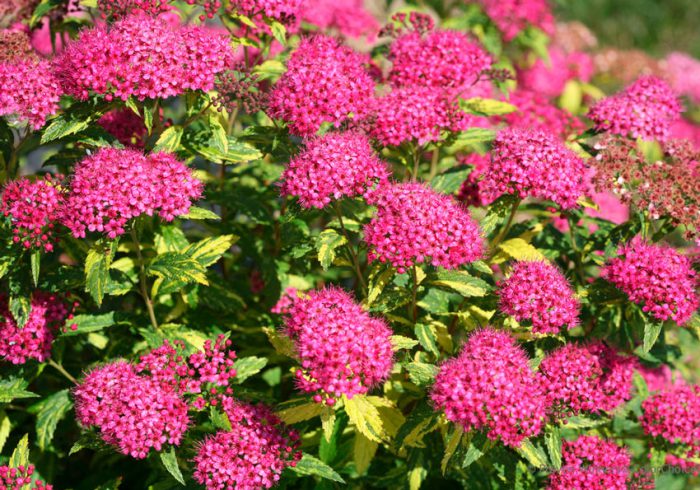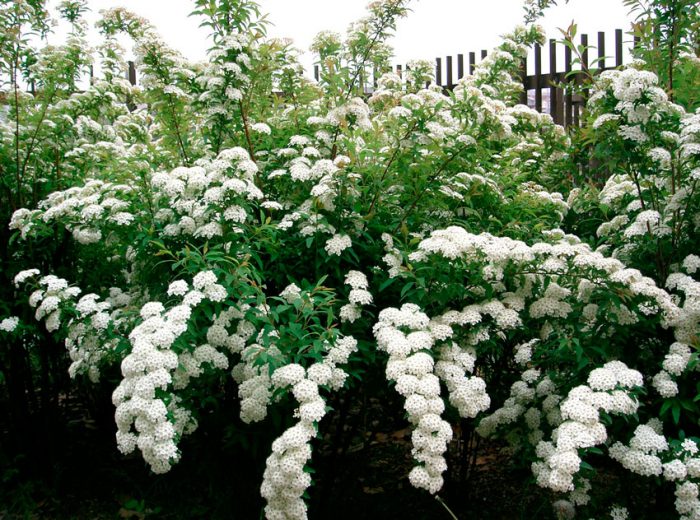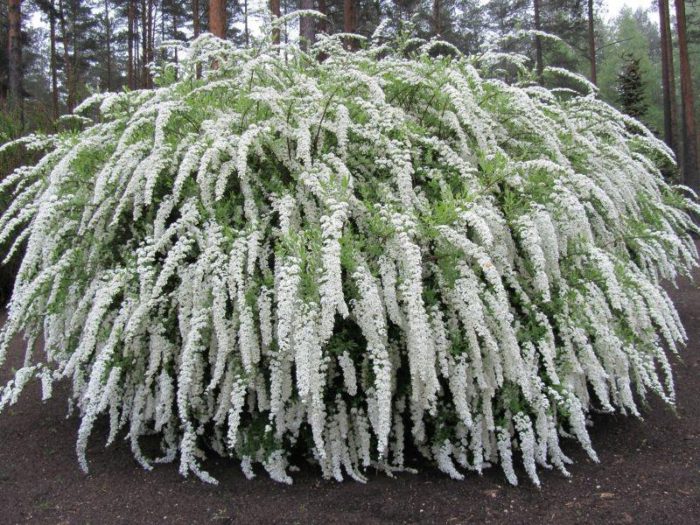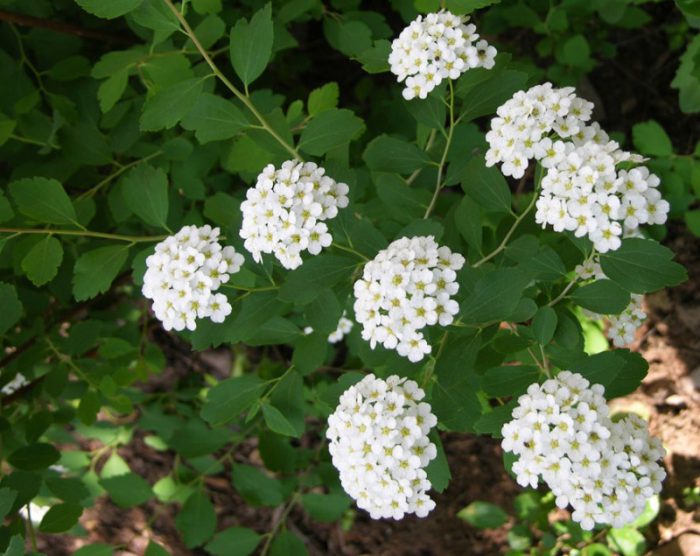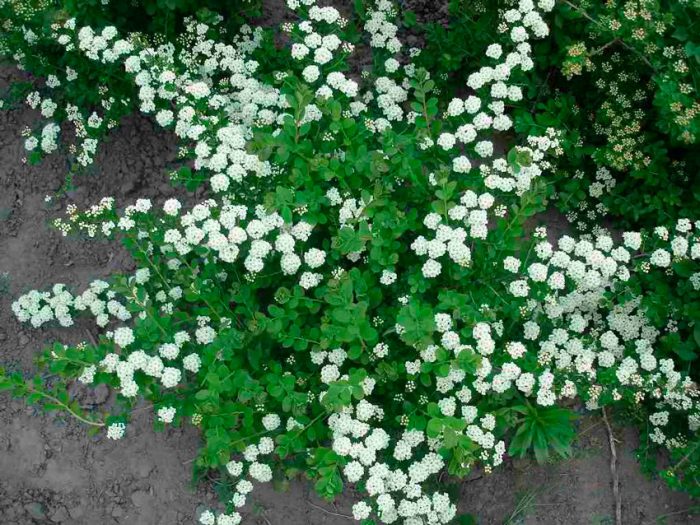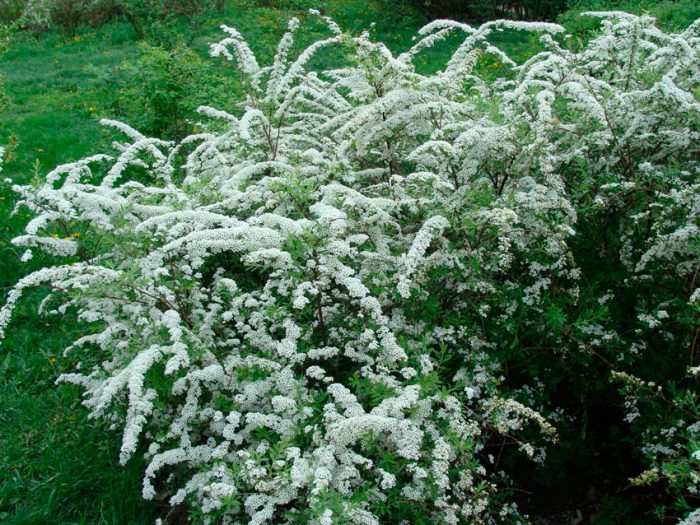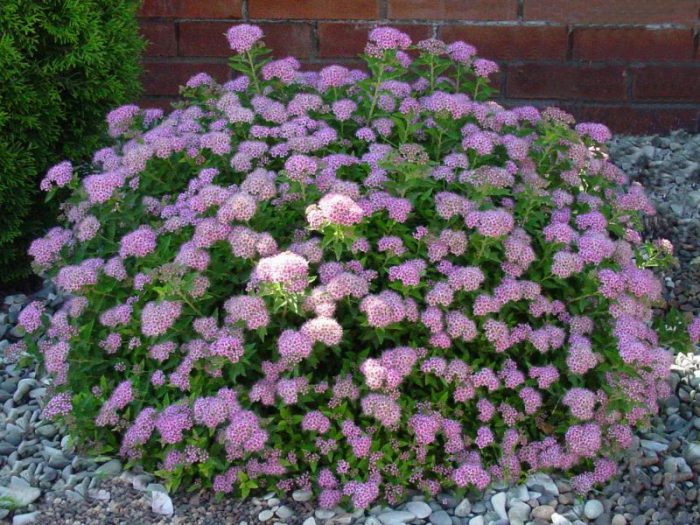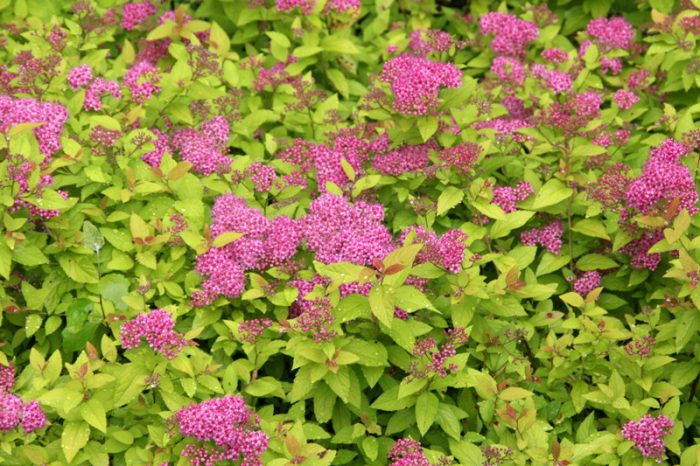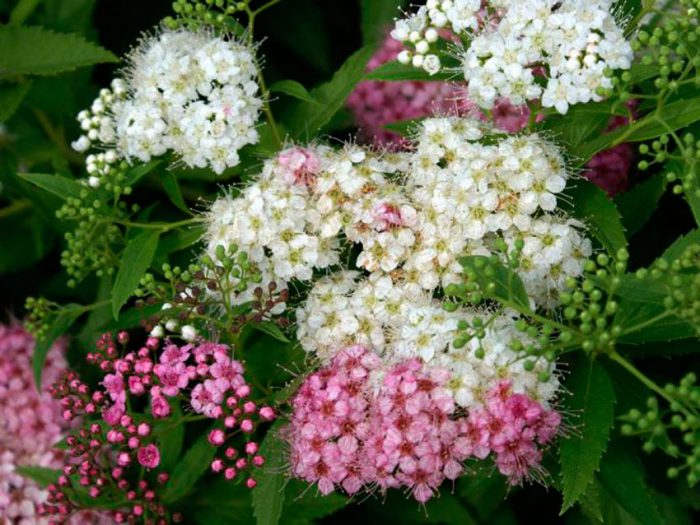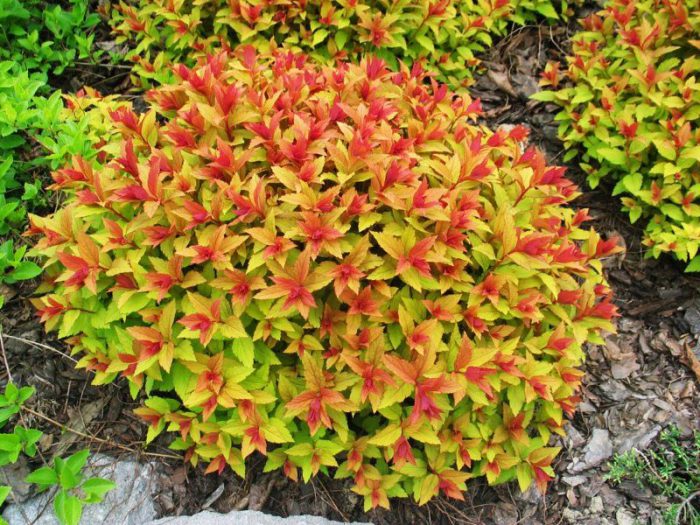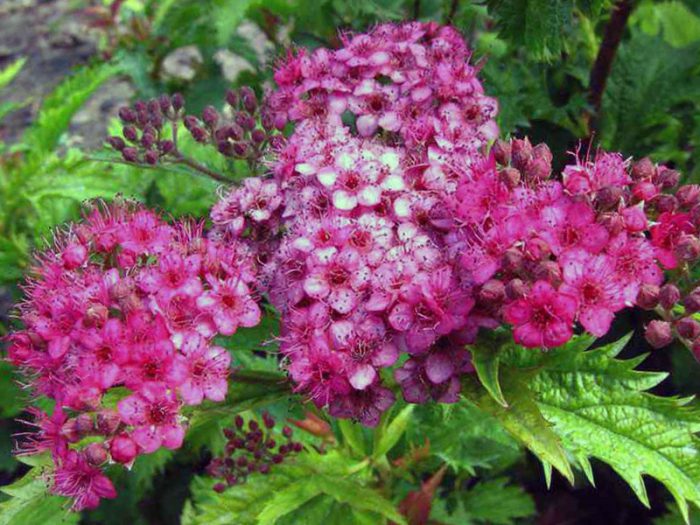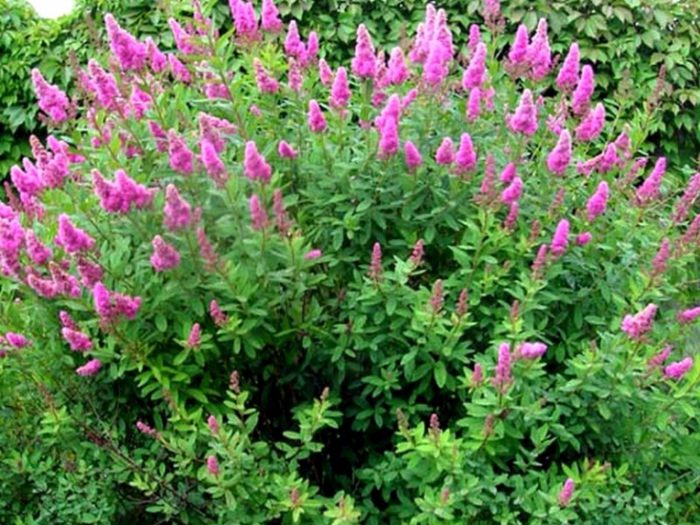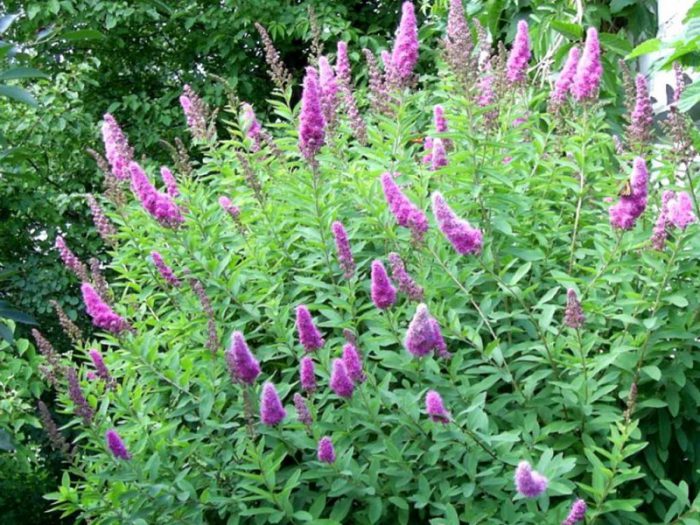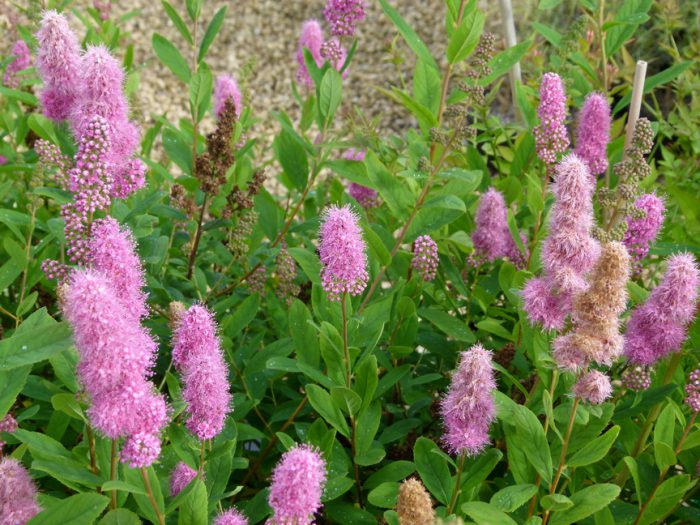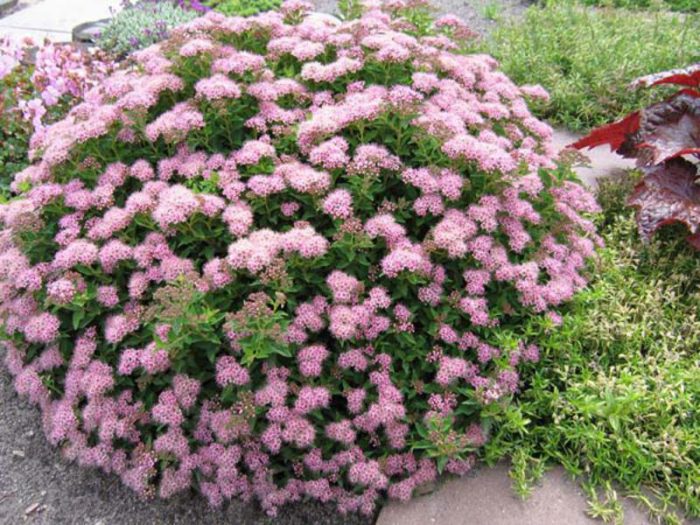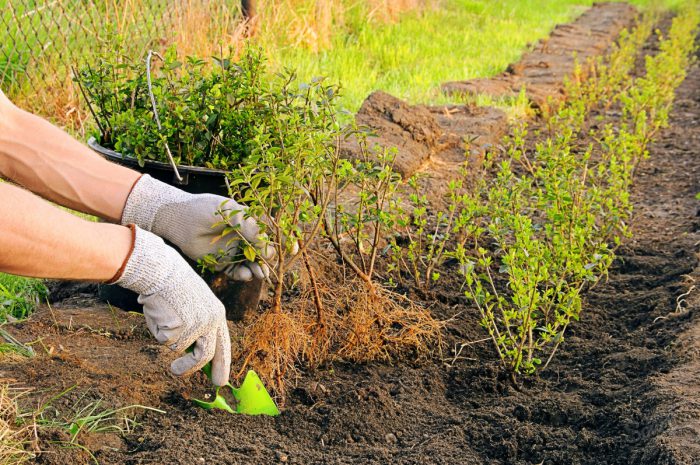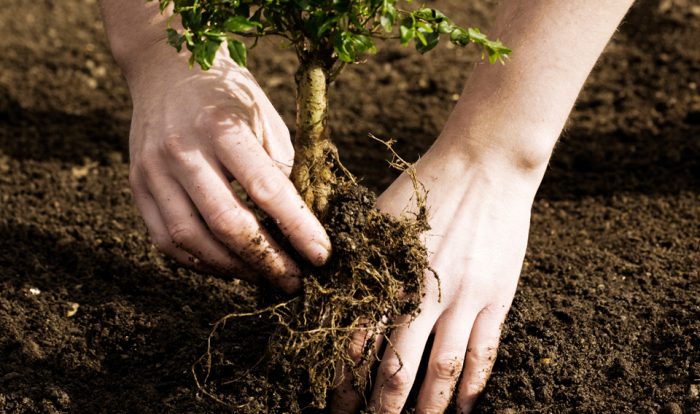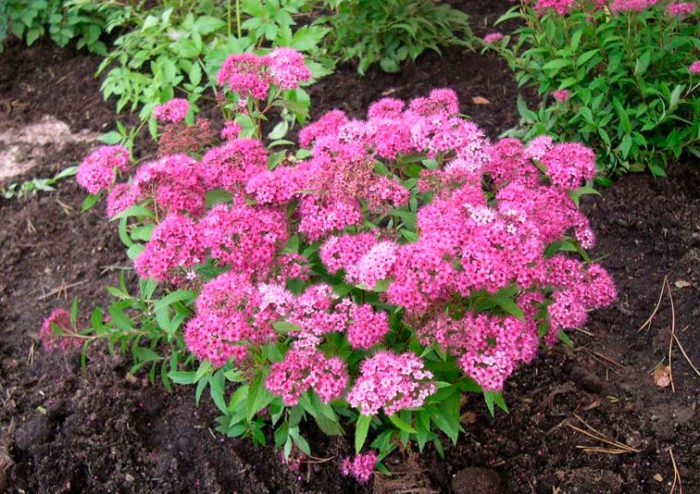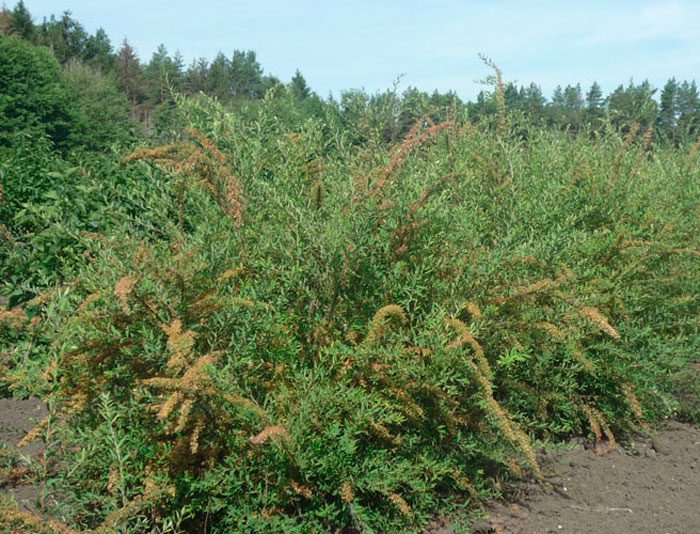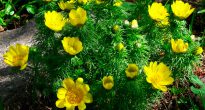Spirea (Spiraea), or meadowsweet is directly related to the genus of deciduous ornamental shrubs and to the pink family (Rosaceae). From ancient Greek "speira" is translated as "bend", this is due to the strong flexibility of its stems. This plant is considered unpretentious. This genus unites about 100 species, these plants prefer to grow in forest-steppe, steppes and semi-deserts. The first mention of this plant, which was then called meadowsweet, was noted in the epic "Sadko", written about 1478. And in the 19th century. V.I.Dal introduces information about this plant in his dictionary, where he says that thin and very strong stems of meadowsweet were used for whips and ramrods. Today, a large number of different species and varieties of meadowsweet are cultivated, which stand out for their high decorative qualities, as well as frost resistance and long flowering.
Content
Features of the spirea shrub
Spireas are found both quite tall (about 2.5 m) and miniature (about 15 centimeters). There is a fibrous, not very deep root system. Branches are both erect and creeping, lying or outstretched. They can be dark to pale brown in color. The bark is capable of flaking longitudinally. Petiolate alternate leaf plates have from 3 to 5 lobes and are rounded or lanceolate. Spirea inflorescences consist of a large number of small flowers, and they can have a spike-like, corymbose, paniculate or pyramidal shape. Flowers can be painted in different color shades from crimson to snow-white. The location of the inflorescences directly depends on the species. So, there are species in which they are located throughout the stem, in others - only in the upper part, and in others - only at the ends of the branches. You can propagate meadowsweet by layering, seeds, dividing the bush or cuttings.
Such a plant is great for creating hedges, as well as for group plantings. At the same time, dwarf varieties are widely used for rocky gardens, rockeries, as well as for living "carpets". Also, the meadowsweet bush looks very impressive as a single plant.
Types and varieties of spirea with photo
Some species and varieties are more popular, others less. All spireas are divided into spring-flowering and summer-flowering by the time when they start flowering.
Spring blooming
These plants bloom very early. Another feature is their lovely flowers, which can be painted in a variety of shades of white. Inflorescences grow on last year's stems. Flowers begin to appear on the shoot only in the 2nd year of its life. These meadowsweet have a rather strong tillering. The following types are most popular among florists:
Spirea gray
Such a hybrid plant was born thanks to the crossing of whitish-gray spirea and St. John's wort. The flowers are white, and the plant is called gray because of the color shade of its leaves. The height of the bush does not exceed 180 centimeters. On drooping branches there are greenish-gray lanceolate leaf plates (their seamy side is gray). White flowers are part of corymbose inflorescences, which are located along the entire length of the branch. Flowering lasts from the second half of May to mid-June. The most popular variety is the gray spirea "Grefsheim". The height and the diameter of the bush vary from 150 to 200 centimeters. Brown-red drooping branches form a spreading crown. Terry snow-white small (up to 1 centimeter in diameter) flowers are part of the umbrella-shaped inflorescences. This meadowsweet is a melliferous plant, its flowering lasts 1.5 months and begins already from the second year of life.
Spirea Wangutta
This hybrid plant was obtained by crossing the three-lobed and Cantonese spirea. The bush is quite large, so its height and diameter are about 200 centimeters. On drooping branches, there are three-lobed, bare, jagged leaf plates, the front side of which is dark green, and the back side is gray. In autumn, the leaves change their color to orange-red. A large number of hemispherical inflorescences are located along the entire length of the branches, which include white flowers with a diameter of 6 mm. Flowering in the second half of June, it happens that in August there is a repeated flowering.
Spirea nippon
Homeland is the island of Honshu. The height of a bush with a dense spherical crown reaches 200 centimeters. On horizontally located branches there are leaf plates up to 4.5 centimeters long, they remain green until late autumn. Flowering begins in the first days of June and lasts about 3 weeks. Corymbose inflorescences consist of greenish-yellow flowers one centimeter in diameter. Interestingly, the buds are purple.
Spirea Argut
This meadowsweet blooms earlier than all spring flowers. In height, a spreading and very showy bush reaches 150-200 centimeters. During flowering, its drooping branches are completely covered with a huge number of snow-white fragrant flowers that seem to flow over them. Flowering begins in the last days of May and lasts about 3 weeks.
Summer blooming
Inflorescences of such plants grow on the tops of young shoots. Old shoots left over from that year dry out over time. Japanese spirea varieties represent most of the summer flowering. Most often, the flowers are pink, but they can be pinkish-red or red. The most popular types:
Japanese spirea
Young shoots with tomentose pubescence look very impressive, as they age they become naked. The bush in height can reach 100-150 centimeters. The seamy side of the oblong ovoid leaves is colored gray, and the front side is green. In autumn, they turn red, yellow or purple. Flowering lasts about 1.5 months. Shield-paniculate inflorescences consist of pinkish-red flowers that grow at the ends of the stems.
Most popular varieties:
Spirea japanese little princesses
The rounded crown reaches 120 centimeters in diameter, and the height of the bush is 60 centimeters. The dark green leaf plates are oval in shape. Pinkish-red flowers with a diameter of 3-4 centimeters are collected in corymbose inflorescences.This slow-growing plant blooms in June-July.
Spirea Japanese Golden Princess
This is a variation of the previous variety. Its difference is in the meter height of the bush and yellow leaf plates.
Spirea Japanese Shirobana
The height of the bush is from 60 to 80 centimeters, and the diameter of its crown is 120 centimeters. Two-centimeter dark green leaves have a narrow-lanceolate shape. Flowering begins in July or August. The color of the flowers is pink or white.
Spirea Japanese Goldflame
The bush reaches 80 centimeters in height. Its orange-yellow leaves gradually acquire a rich yellow color, then yellowish-green, and in autumn they become copper-orange. The small flowers are pinkish-red.
Spirea Japanese Crispa
The crown of the spherical shape is slightly more than 50 centimeters, and the height of the bush is 50 centimeters. There are a large number of erect stems. Flat, umbrella-shaped inflorescences reach 5.5 centimeters in diameter, they consist of small light pink flowers, casting lilac. Flowering begins in July and lasts 6-8 weeks.
Spirea Bumald
This hybrid plant is obtained by crossing the white-flowered and Japanese spirea. A bush with erect stems reaches a height of 50–80 centimeters. Green leaves in autumn change their color to purple, red or yellow. Flowering lasts approximately 2 months and begins in July. The flowers can be painted in various shades from dark to light pink. The most popular is the Spirea variety Bumalda Goldflame. The height of the bush is 80 centimeters. Young leaf plates have an orange-bronze color, gradually they become golden yellow, and then greenish-yellow. And in autumn, they turn reddish-coppery. However, these changes are observed if the bush grows in a sunny area, and in a shady place its foliage has a green color.
Spirea willow
The height of the bush reaches 200 centimeters. The upright stems are yellow-brown-reddish. The length of the pointed leaf plates is about 10 centimeters. The length of the paniculate-pyramidal inflorescences is approximately 20 centimeters. They include pink or white flowers.
Spirea Douglas
The height of the bush is about 150 centimeters. On the surface of its straight brownish-red shoots is pubescence. The length of the oblong-lanceolate leaf plates varies from 3 to 10 centimeters. Narrow apical pyramidal-paniculate inflorescences consist of dark pink flowers. Flowering begins in July and lasts 6 weeks.
Spirea Billard
This hybrid plant was obtained by crossing spirea willow and Douglas. The bush reaches a height of 200 centimeters. The length of its broad-lanceolate leaf plates is 10 centimeters. Narrow paniculate-pyramidal inflorescences reach 20 centimeters in length and consist of deep pink flowers. Flowering begins in the second half of July.
Growing features
Any plant has any peculiarities in caring for it and spirea is no exception:
- Best of all, such a plant develops and grows on sod or leafy ground. Recommended composition of the soil mixture: earth, sand and peat (2: 1: 1).
- At the bottom of the hole, you need to make a drainage layer, for example, from broken brick.
- The landing hole should be 1/3 larger than the spirea butt size.
- You need to plant at a depth of at least 50 centimeters, while making sure that the root collar is flush with the soil surface.
- It is recommended to plant this plant on a cloudy day, and best of all during rain. The optimal time for disembarkation is September.
- Spruce, juniper and thuja feel great next to meadowsweet.
Planting spirea
Planting spirea in spring
In springtime, only those spireas that bloom in summer can be planted. In this case, it is imperative to plant such shrubs before the buds begin to open.When buying seedlings, pay special attention to the root system. If it is too dry, then you should not take such a seedling. You also need to examine the shoots. They must be flexible and accommodate good kidneys. After purchasing the seedling, you need to prepare it for planting. So, if its roots are too long, then they must be carefully trimmed so that they become shorter. In the event that the roots are overdried or damaged, it is necessary to prune all branches. If the seedling has been stored for a long time, and its roots have become too dry, then they must be moistened or immersed in a container of water for a few minutes, and only after that you can start planting.
Although such a plant is distinguished by its unpretentiousness, in order to enjoy the abundant flowering as long as possible, it is necessary to choose a well-lit area with nutritious soil. And do not forget when choosing a site that this shrub gives abundant root growth.
First you need to make a hole for the seedling. It should have sheer edges. Its volume should be at least 1/3 part larger than the spirea root system. Then leave the pit alone for 2–4 days. For planting, it is recommended to choose a cloudy, or better rainy day. Immediately before planting, it is necessary to lay a drainage layer of broken bricks on the bottom, which should have a thickness of 15 to 20 centimeters, especially if the soil is clay. Then you need to prepare the soil mixture. for this, combining sod (leaf) land, sand and peat, taken in a ratio of 2: 1: 1. Pour the mixture into the hole and dip the roots of the seedling into it. Gently straighten them and fill the hole with an earth mixture, tamping it slightly, so that the root collar is flush with the soil surface. After the bush is planted, it will need to be watered using 20 liters of water, and then the soil surface should be covered with mulch (peat).
Planting spirea in the fall
In the autumn, both spring and summer flowering spirits are planted. As a rule, during planting in the autumn, the bush is divided. At the same time, it is necessary to plant the shrub before the end of the leaf fall. Bushes that are 3-4 years old are perfect for dividing and transplanting. Of course, this procedure can be performed with more mature spireas, but it should be borne in mind that this will be quite difficult, since such plants have a rather voluminous and heavy root system (taking into account the earthy coma).
Dig out a bush, while you need to grab a little more than ½ part of the crown projection around the circumference. If you chop off some of the roots, then the shrub will not suffer from this. After that, the root system is thoroughly washed in running water. In the event that the bush is young and its root system is small, then it can be placed in a container (bucket) and filled with water. After some time, you need to rinse the roots under running water and straighten them at the same time. Using a pruner, divide the bush into 2-3 divisions. It should be borne in mind that each separated part must have a good root lobe and 2 or 3 strong stems. The cord-like roots must be trimmed.
Pour the soil mixture with a mound into the prepared hole. Then they put a cut in it and straighten the roots. The hole must be covered with soil and not tamped very hard. Water the planted plant in several doses.
Spirea care
How to care for spirea
As mentioned above, spirea is a fairly light-loving plant, however, there are also species that feel great in a shaded place. The plant also needs a loose nutritious soil, a good drainage layer, and also a layer of mulch on the soil surface, the thickness of which should be about 7 centimeters.
Since the root system of the spirea is not located very deeply, it should be watered often and moderately. So, in dry times, it is necessary to pour 1.5 buckets of water for each bush once every 2 weeks.You also need to regularly loosen the topsoil and pull out weeds. The first time you need to feed the plant after pruning, for this, a complex mineral fertilizer is used. In mid-July, it is recommended to fertilize the shrub with a mullein solution, to which superphosphate must be added (10 grams of substance per bucket of solution).
Most often, spider mites and aphids settle on this plant. You can get rid of aphids by means of pyrimor, and from spider mites - by karbofos. As a rule, spireas are highly resistant to diseases, and pests settle on them extremely rarely and do not cause significant harm to them.
Trimming the spirea


Watch this video on YouTube
Bushes are able to grow in a relatively short time, in this regard, pruning must be carried out systematically. In spring flowering plants, inflorescences are located along the entire length of the branches, and therefore, once a year, they only need to cut off the ends of the branches that are frozen during the winter cold. However, after 7-14 years, all old stems are cut off from the bushes, or rather, the spireas are cut almost to the stump. After the young growth appears, it is necessary to choose from them 5-6 of the strongest stems to form a bush. In this case, other stems will need to be cut off completely. After 1-2 years, all weakened or old stems should be cut off from the bush. The tips of the branches are cut off exclusively in spring until the buds are fully expanded. Old stems can be removed even in the spring, even in the summer.
Late flowering species and varieties should be cut off every year at the very beginning of the spring period. Stem pruning is carried out to the first bud, while weakened and small shoots must be cut out completely. It is necessary to cut off old stems in a timely manner, as they gradually begin to dry themselves. After the spirea survives to the age of four, it is recommended to cut it off annually to a height of about 30 centimeters from the soil. If, after such a procedure, the growth is rather weak, it is best to replace the shrub. As a rule, summer-flowering species live for about 15-20 years.
Reproduction of spirea
You can propagate by seeds, dividing the bush, layering and cuttings. Seed propagation is not suitable for hybrid varieties, since such plants cannot retain varietal characteristics. The best method is cuttings, because about 70 percent of all cuttings give roots very quickly even without the use of growth stimulants. Spring-flowering species should be cuttings in the first weeks of June, and summer-flowering species - from mid-June or in July. Rooting of woody cuttings should be done in September or October.
It is necessary to cut off the one-year straight stem and divide it into pieces. It must be remembered that there should be 5 or 6 leaf plates on each cutting. The leaves that are below should be cut off with petioles, and those that are located at the top should be shortened by ½ part. After that, the stalk must be placed in an epin solution for 12 hours (1.5 ml of substance for 3 liters of water). Then the knot located below should be dipped into the root, and then planted in a container filled with moistened sand, and the cutting should be at an angle equal to 30 to 45 degrees. Cover with foil or glass. Remove them to a shaded place and moisten them 2 or 3 times a day with a spray bottle. After the frost begins, the cuttings need to be dug in the garden bed and covered with dried leaves on top. A box must be placed on top of them, having previously turned it over, and so they must stay until spring. After they have young shoots next year, they are planted in a permanent place.
In order to propagate by layering, you need to make a groove in the soil and put a stem in it, which is fixed and covered with soil. To get several young shoots at once, it is necessary to pinch the upper part of the layer.In this case, all lateral buds will be able to give the process. In autumn, the cuttings must be obtained and divided into the resulting shoots. They need to be put in a permanent place.
Spirea after flowering
It is very simple to prepare such a shrub for wintering. Almost all types of spirea are distinguished by good winter hardiness. If you are worried that the winter will be too cold and with little snow, then cover the root system with dry foliage, while the layer thickness should be 10-15 centimeters.

